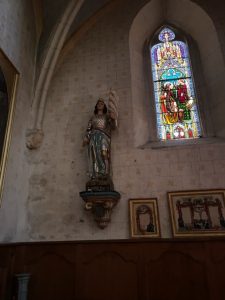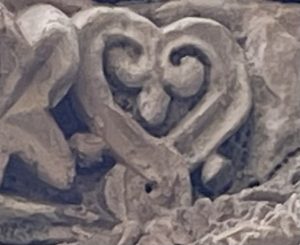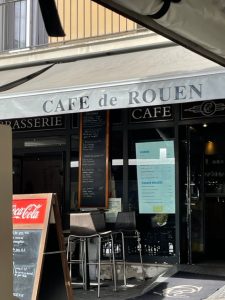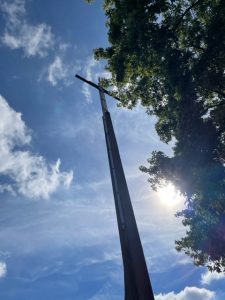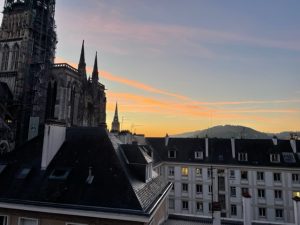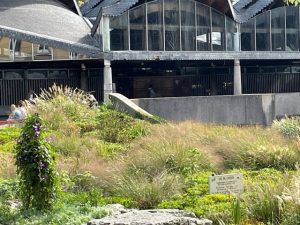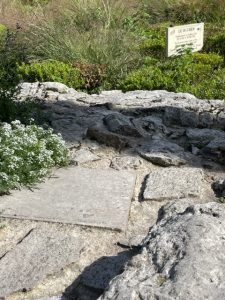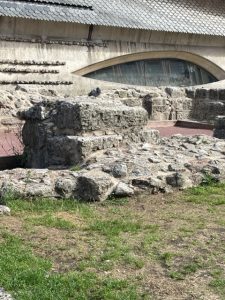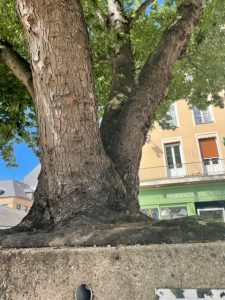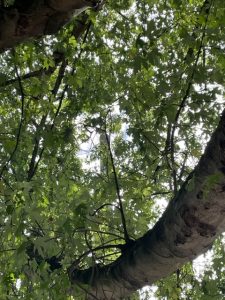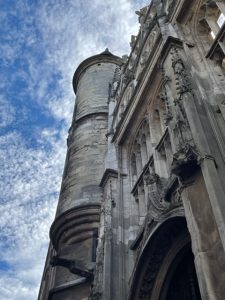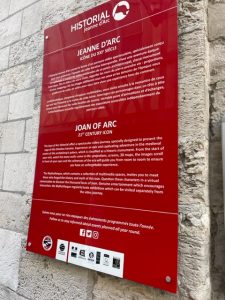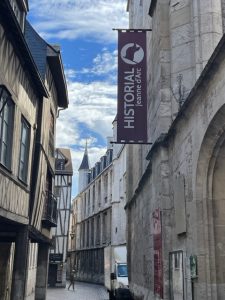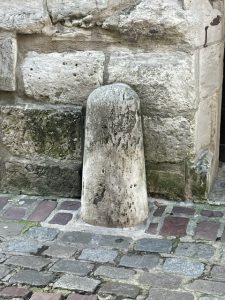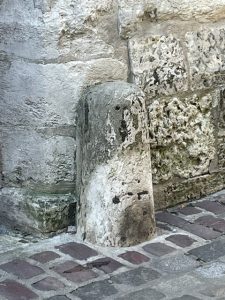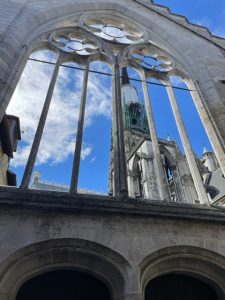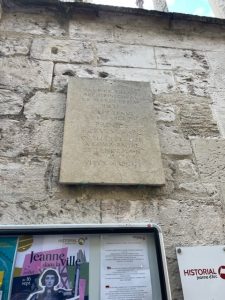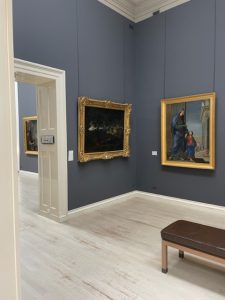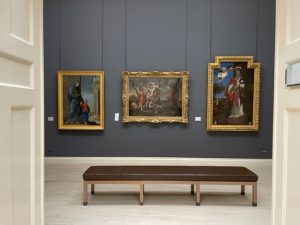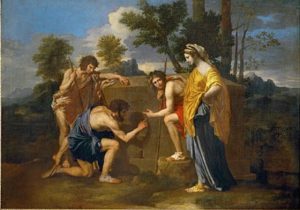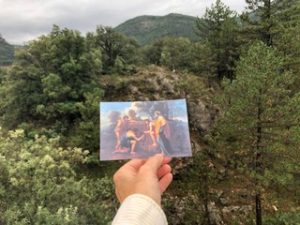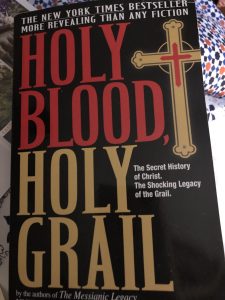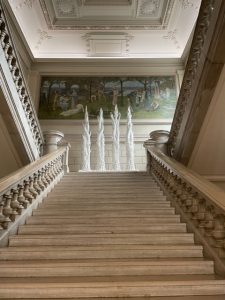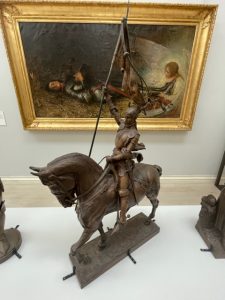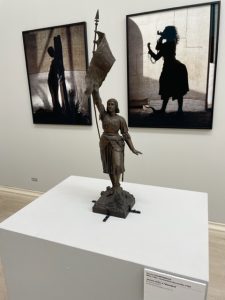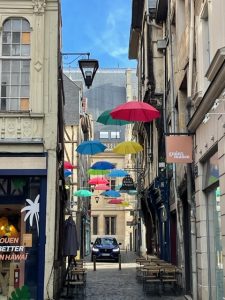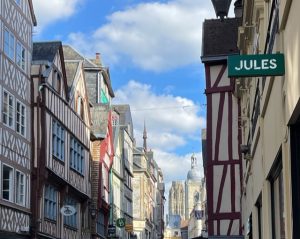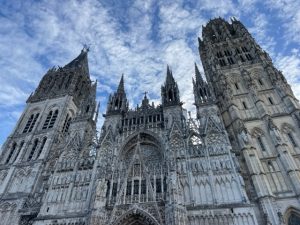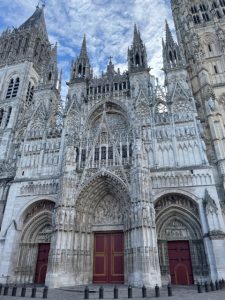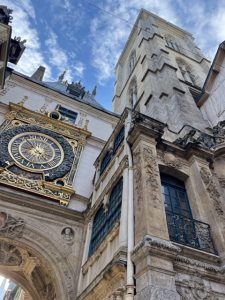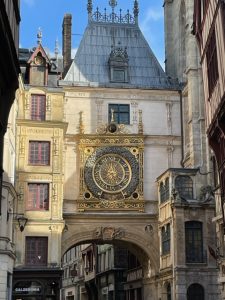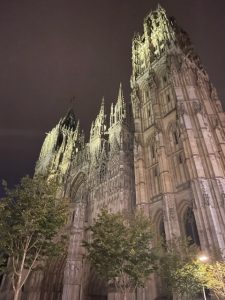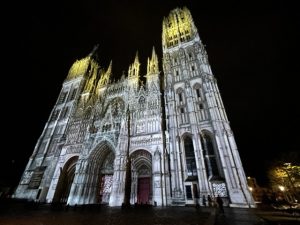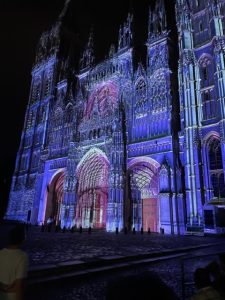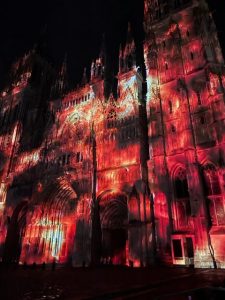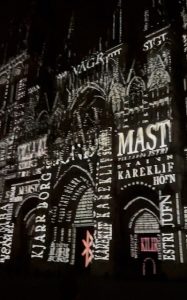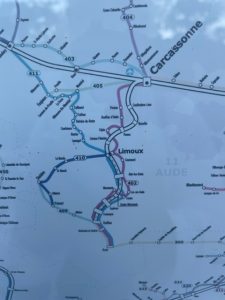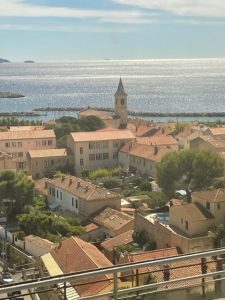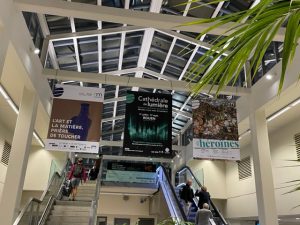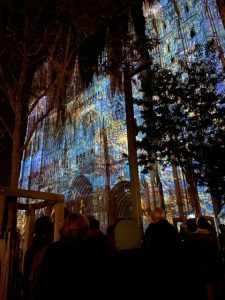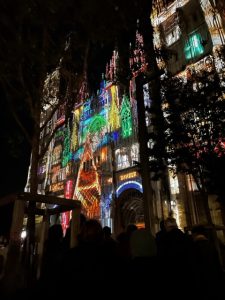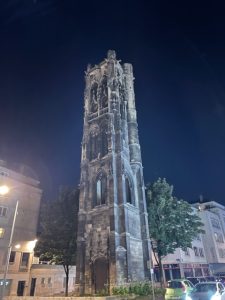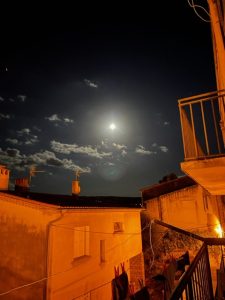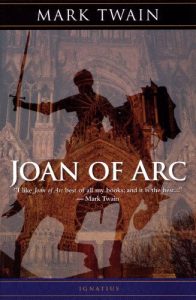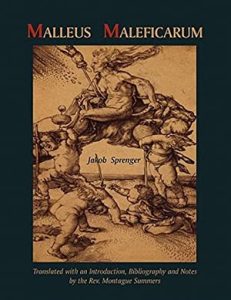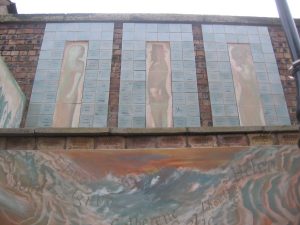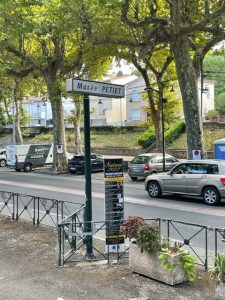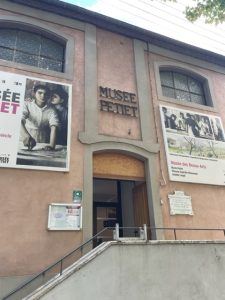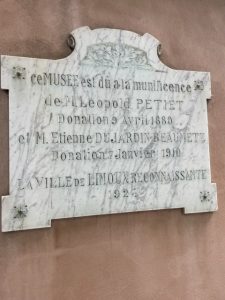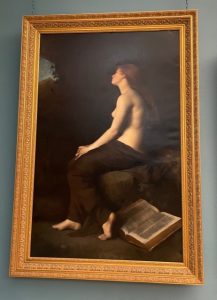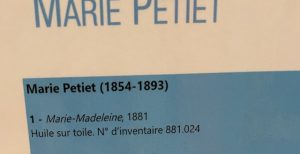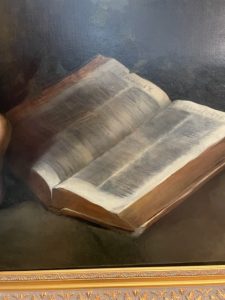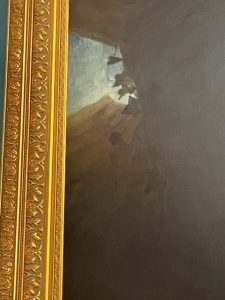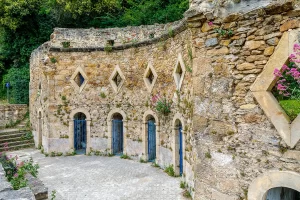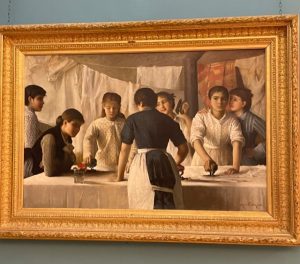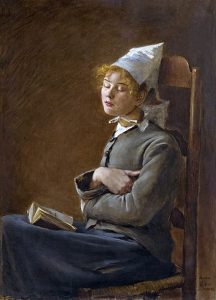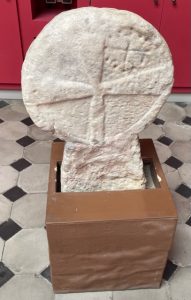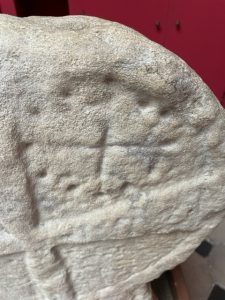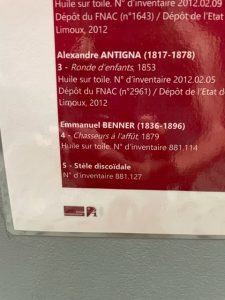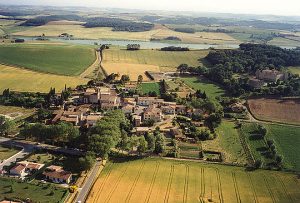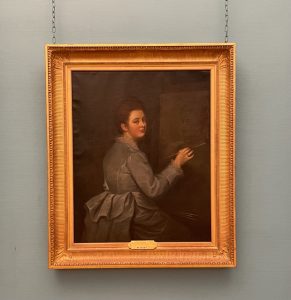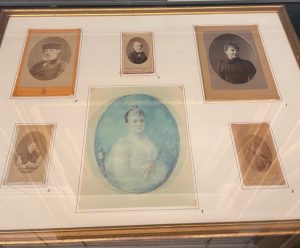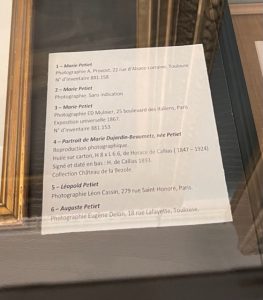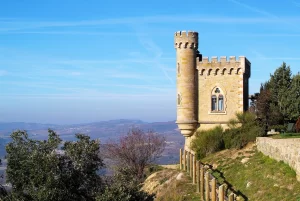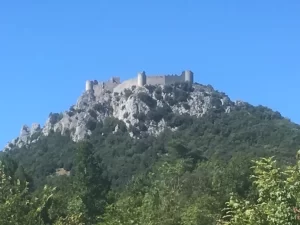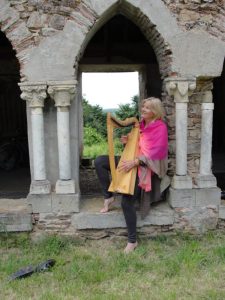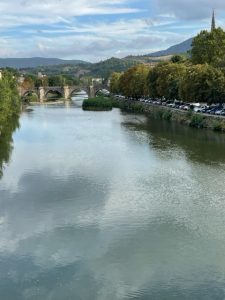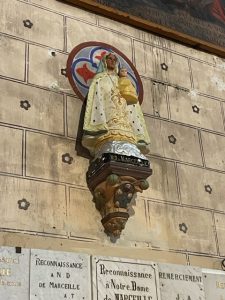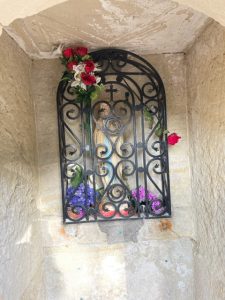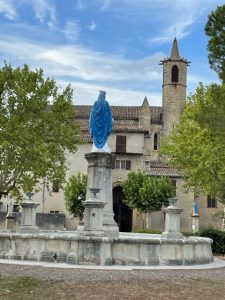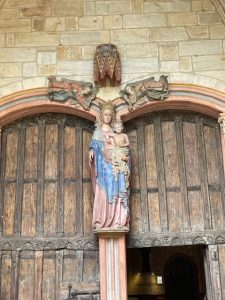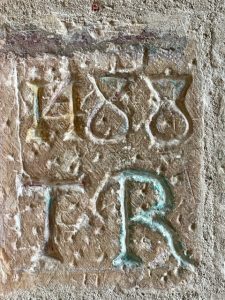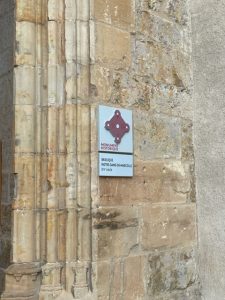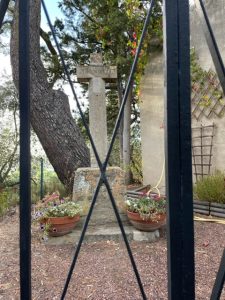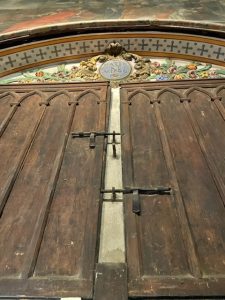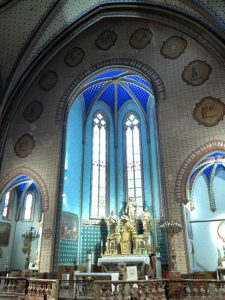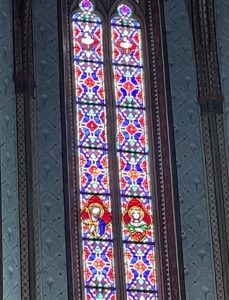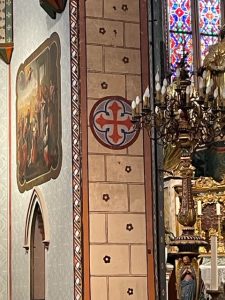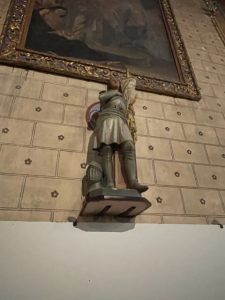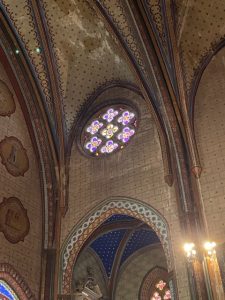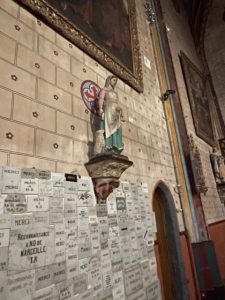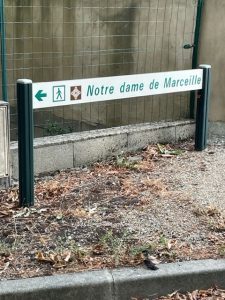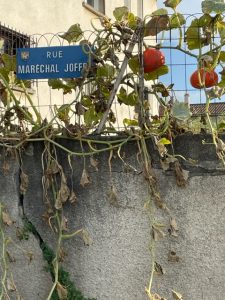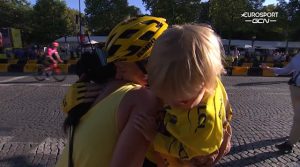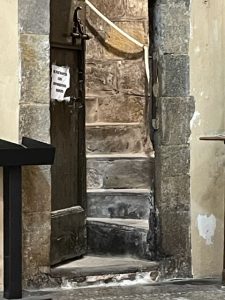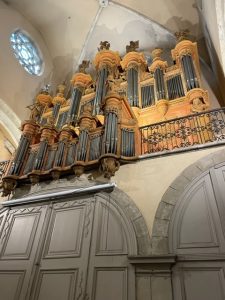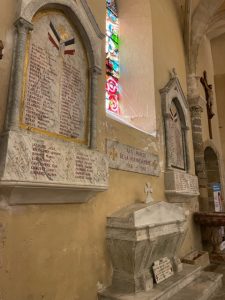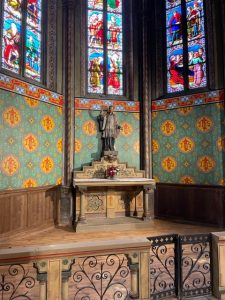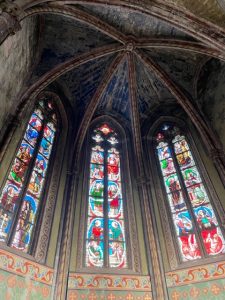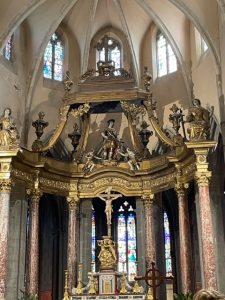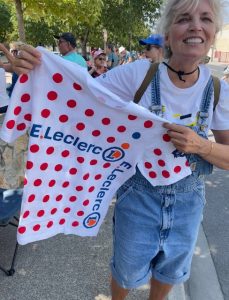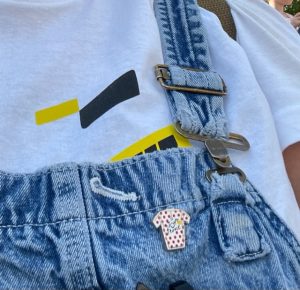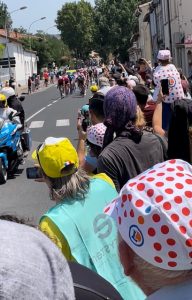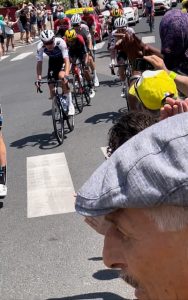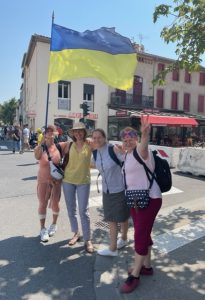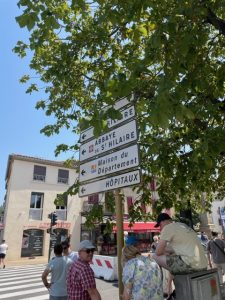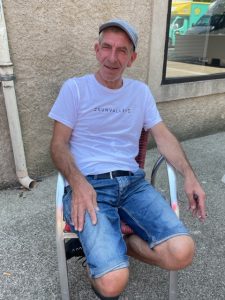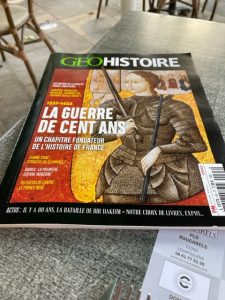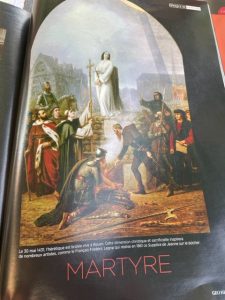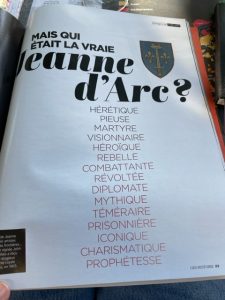Joan of Arc
Dayle in Limoux – Day #75
September 18, 2022by Suleika Jaouad
‘…but I’m still yearning. It’s different now, in that it’s not specific things, just the word: more. That’s the bittersweetness of being granted your wishes, then facing the prospect of losing them. I love my life—my family, my husband, my sweet new dog, my friends, my home, my garden, my work, and this beloved community—and I want to be able to enjoy that life, today and tomorrow and for many years to come.
But with this illness and all the treatment side effects, I can’t rely on my body from hour to hour, much less day to day or week to week, which makes planning or making commitments so difficult. It’s strange to have a sense of urgency to make and do and see, but to also have a body that often just can’t. It’s a particular kind of entrapment.
So here at the beginning of fall, instead of embarking on some grand adventure, I’m rejoicing in the moments where I can enjoy a small one. One day last week, while out at my farmhouse, I woke up feeling… well, feeling like I hadn’t just consumed a dose of rat poison. I have two electric bikes, and that afternoon, my friend Kristen and I hopped on and started speeding down the winding country roads, past babbling brooks, under covered bridges, up into the hills. After awhile, we stopped at a plant nursery with a little outdoor bar and lounge and had cocktails—something I hadn’t done in a very long time. By the time we left, the sun was setting, and I felt almost giddy. That afternoon, I’d had more.
[Alet-les-Bains in Languedoc, France.]
From Fr Richard Rohr, Center for Action and Contemplation.
Old age, as such, is almost a complete changing of gears and engines from the first half of our lives, and does not happen without many slow realizations, inner calmings, lots of inner resistance and denials, and eventual surrenders. All of them by God’s grace work with our ever-deepening sense of what we really desire and who we really are.
Reality, fate, destiny, providence, and tragedy are slow but insistent teachers. The horizon of old age seems to be a plan that God has prepared as inevitable and part of the necessary school of life. What is gratuitously given is also gratuitously taken away, just as Job slowly came to accept.
If we are to speak of a spirituality of ripening, we need to recognize that it is always characterized by an increasing tolerance for ambiguity, a growing sense of subtlety, an ever-larger ability to include and allow, and a capacity to live with contradictions and even to love them! I cannot imagine any other way of coming to those broad horizons except through many trials, unsolvable paradoxes, and errors in trying to resolve them.
The ripening of mind and heart is most basically a capacity for nondual consciousness and contemplation. So my guidance is a simple reminder to recall what we will be forced to learn by necessity and under pressure anyway—the open-ended way of allowing and the deep meaning that some call faith. To live in trustful faith is to ripen; it is almost that simple.
There she is. Johanne. Joan of Arc.
At Église Saint André in Alet-les-Bains.
L
O
V
E
It finds us.
Bonne Nuit.
ღ
Dayle in Limoux – Day # 69
September 12, 2022
Place du Vieux-Marche’, Old Market Square, where Joan of Arc was burned at the stake. Apparently, Joan’s body was burned three different times, and her burning was prolonged by the sadistic executioners to lengthen her pain and torture.
From The Guardian:
‘What is generally agreed is that Joan’s body was burnt three times by the English and ashes from the foot of the pyre were supposedly discovered in 1867, lurking in the Paris loft of an apothecary .
French scientists, who have been studying those ashes, confirmed (in 2006) that a piece of cloth found among the remains may have been a fragment of Joan of Arc’s gown. A new series of DNA tests of bones and tissue found among the ashes is expected to confirm that they belong to a female.
The most exciting discovery by his 18-strong team at the Hôpital Raymond Poincare near Paris was in the carbon-dating of the piece of cloth. ‘It is linen of high quality and we can confirm that it dates from the 15th century. It could have been a robe or a bag.’
According to historians, Joan of Arc was 19 when she was burnt at the stake in Rouen by the English on 30 May, 1431. She died of smoke inhalation. The Cardinal of Winchester is recorded as having ordered her to be burnt a second time. Her organs still survived this fire, so a third burning was ordered to destroy the body completely. Her cinders and debris were to be thrown into the Seine.
However, in 1867 ashes that were said to include remains of Joan of Arc were found in the Paris loft of an apothecary. These were transferred to a museum in Chinon where they are still kept.
I spent the entire morning at this sacred spot in the Old Market Square. I started at the Rouen Cafe, and then settled closer to where she was burned.
A massive crucifix is placed in the exact spot where Joan was burned alive. Reportedly, Joan asked to be able to see the cross as she was being executed. The last word she screamed was, “JESUS!”
(The bells of the cathedral are ringing now. Sometimes, not knowing the reason, they just ring and ring in these magnificent harmonies. So incredibly beautiful. Those deep, melodic, bellowing tones. Many bells surround the square. Inspiring. And to wake up with them in the morning, ethereal. This is first light today from my window…
Back to Joan. :)
This is the base of the giant crucifix, with the Joan of Arc church and her statue just behind.
And these are ancient stones from Joan of Arc’s time that were left in place at the Old Market Square.
Here’s the tree where I sat under for prayers and meditations this morning…I could see the crucifix through the branches.
So peaceful. Tranquil. It’s Monday, and after the many tourists left from the weekend, the locals were out and about on their bikes; on Mondays, many establishments are closed, I learned brokenheartedly. Still, able to see and explore so much.
When I finally pulled myself away from the Old Market Square, I trekked to find a historical monument where Johanne was tried and convicted, imprisoned, after being betrayed by her country and king, Charles the VII. Supposedly there’s this interactive virtual thing we can take part in, not typically my thing, yet, rave reviews. I found it! Sadly, one of the establishments that are closed on Mondays. Next time. I was able to linger awhile and take in the historic splendor, knowing Joan was there, her energy, her eloquence, your loyalty, and her truth. History shows her arguments were pure in logic, and forthright, often beleaguering the m e n trying to convict her. Their minds were made up, if not, she would have walked free.
Look at these ancient standing stones! Made up for the fact the historical establishment was closed. :) They are placed on each side of the door.
This is the courtyard right next to the historical site. Legal hearings? Council? Not sure.
And these are the two ancient plaques, explaining what transpired with Joan. After her execution, it is here Charles VII said, whoops, our bad. She was declared innocent. Sorry about the burning thing. And in 1920, of course centuries later, not unlike Mary Magdalene, her virtues and faith and historical contribution were recognized, and she was canonized as a saint.
From here, knocked out to learn that at the art museum in Rouen, there are three original paintings by Nicolas Poussin!
Poussin was actually from Normandy, and Rouen is the capitol of Normandy. There’s a statue of him outside the museum…
If you’re following the Dayle in Limoux posts, you know he painted ‘Et in Arcadia Ego’ which is based on the sacred geometry in Languedoc and Renne-les-Chateau…the Cathars.
This is a capture from 2019, visiting the site of the ‘tomb,’ no longer there because the owner of the property was tired of the visitors. He destroyed it. Tragically. This photo was taken in Languedoc, aligning with the sacred geometry.
Everything Sir Henry Lincoln wrote about with his co-authors in the book that started the intrigue all over again.
Here’s a couple of YouTube reviews.
Pousinn’s French Baroque style was also considered French Classical tradition. He was a major inspiration for such classically oriented artists as Jacques-Louis David, Jean-Auguste-Dominique Ingres, and Paul Cézanne.
This later version of Et in Arcadia Ego has a far more (sacred!) geometric composition, and the figures are much more contemplative. The mask-like face of the shepherdess echos the Classical “Greek profile”. And! It’s in the Louvre. Someday, when I get back to Paris. Can’t wait. If I lived in Paris, I would go the Louvre every weekend. I would!
From thegoodlifefrance.com:
Joan of Arc claimed to have communicated spiritually with saints at a rural location some two kilometres from her home. She identified them as Michael the Archangel, St. Catherine of Alexandria and St. Margaret of Antioch. The last two saints were virgin martyrs who had refused to take orders from men and, when leading the French army into battle, Joan dressed as a man to avoid prejudice. The spot is well marked. An extremely grand and prominent Basilica was built at the location as late as 1881. Masses are held there every Sunday and great mural artworks portraying her military capacity surround the walls. In the grounds around it, visitors will find impressive sculptures and statues of Joan, the saints that communicated with her and her pious father Jacques, who shaped her childhood. The Basilica is impressive, features a vast spire and can be seen from miles around amongst the local countryside.
Joan of Arc was captured in the city of Compiegne, Picardy at the start of May, 1430. She was held by the conspiring Burgundians who sold her to the English for 10,000 Francs.
Her trial took place in Rouen, the capital city of Normandy. She was convicted of witchcraft and heresy by the English and Burgundian authorities and sentenced to death by burning at the stake in the centre of Rouen on May 30th, 1431. The English executioners apparently went to much trouble to ensure that her death was as slow and distressing as possible. She was just nineteen years old. Twenty years later, a retrial took place in the same courtroom and found her innocent of all charges.
Her exact place of execution is marked by a vast concrete cross. Right next door rests a contemporary church to commemorate her. Digital son et lumiere dramatically presents features of Joan’s life on the face of the city’s Notre Dame Cathedral. The vast Excel walk round cinema on the banks of the Seine River flowing through Rouen, features a similar, stunning feature. The courtroom where she was tried twice, houses an ultra-modern, active digital museum that almost brings her back to life.
Joan of Arc was canonised in 1920 and is the patron saint of France. More than 20,000 books have been written about her. Her persuasion, untaught military skills and undoubted faith in her religious beliefs were extraordinary achievements by one who lived such a short life.
I was able to research and study the Poussin paintings for awhile with the complimentary WiFi in the museum; beautiful structure.
They have a hall dedicated to ‘Heroines,’ too. Many sculpture’s and paintings of Johanne. I’d like to have one of these, please.
And then, from here it was back to the Cathedral to sit in front of Joan of Arc’s chapel. I lit two candles, one each for my two children, William Henry, and Annie Glenn, to keep Joan’s fierce protection surrounding them, and her compassion guiding them.
Look at the light from the stained glass panel.
s
p
i
r
i
t
Some photos from today…captures…and the Cathedral…Rouen is beautiful, ancient medieval architecture with splashes of contemporary color.
Here comes the sun…see it right at the top? 🌞
The clock! From the 1300’s. It still rings at 9:00 at night to signify what was once, ‘curfew.’
And, at night. Tres jolie.
And then, preparation for the light and music show with the cathedral as the giant canvas…on the tallest cathedral in France…✧ * . * ✧ . * . *
. * . * . for the magic. . ✧ .
✧ ✧ * . * . . *. .
✧ * . . ✧ . * . *
This is the Rouen Cathedral of Notre Dame. This year the light and music show runs June 3rd to September 17th. It’s spectacular. Folks say it’s a ‘must-see summer event.’ No doubt. It shares the story of Joan of Arc and the Viking history.
Here’s about 13 minutes someone posted on youtube from this summer. The presentation is about 50 minutes in total. I wish everyone could see it. Incredibly inspirational. We need lots of inspiration on our planet right now. Tell the stories, share the history. Feel what is possible. Thanks be to those who create these beautiful messages when we need them most. Love watching the younger spirits, enthralled, wondering how they will be inspired, what they too will create, sowing those tiny seeds of promise and possibility.
b
e
l
i
e
v
e
https://youtu.be/JFq26L0m5ek
J’adore Rouen. Find the light.
Bonne nuit!
Dayle in Limoux – Day #67
September 11, 2022R
O
U
E
N
F R A N C E
Jeanne d’Arc
Early train from Limoux to Carcassonne to make the connection to Marseilles and then on to Rouen, France, where Joan of Arc was tried and convicted, betrayed by her king and her country, and burned at the stake for being a heretic, that is, a w i t c h. The guys also didn’t like the fact that she wore armor and men’s clothing, which she donned, especially when in prison, to protect herself against sexual assault. (There’s a new play in London called ‘I, Joan’ about a gender non-conforming hero who uses them/they pronouns. It’s playing at Shakespeare’s Globe. Hard pass. I revere her history, and this isn’t it. She is sacred. Leave her be.)
Very long day of train travel to get to Rouen, which I loved. Train travel is the best; and it’s so doable in this country. And not very expensive. Taking the bus is basically a euro in the region of Languedoc.
Waiting for the train in Limoux.
Waiting for the train in Carcassonne.
And the bread of life.
Pain au chocolate. ღ
The Mediterranean heading into Marseilles, where Mary Magdalene landed in Gaul (France) to begin her apostleship to the villagers in the region. (Read, ‘The Manuscript!’)
Marseilles found my stress threshold. B i g station. Had no idea what I was doing; our train was delayed in Carcassonne which put us late into the station. I couldn’t find the right platform, or a screen to tell me which platform it should be. I had 15 minutes to figure it out. A woman with a child was asking people for €’s, as I was hurrying past I gave her the 4 €’s I had in my pocket. Then she started following me. She wanted 10. Impressive. I finally found the platform with minutes to spare…and lots of perspiration.
Another great thing about France, they even grow trees inside.
🌳 🌳 🌳 💚
The first thing I saw when I disembarked from the train…
I have no idea what it is, no markings…I just love it. So old. And the air smelled like flowers. Seriously! It really did. So fresh. Maybe because I was finally able to remove my mask after five hours. :)
[Train station in Rouen.]
When the taxi dropped me at my hotel, I thought I was in a fever dream.
WHAT. IS. HAPPENING.
The Cathédrale Notre-Dame de Rouen was awash in bright colors and pulsating music. It was incredible. My hotel is right across from the Cathedral. So when it was over, I grabbed my bag to go check in. Door locked with a note in English. I think for me. Finally the proprietor comes downstairs to inform me the hotel is overbooked…staff error…and found me another hotel. Drag. So tired. So, I trekked to find it. Got lost. A sweet young Norwegian couple who spoke English (!), helped me find it. It’s a trip. I can only possibly explain it by suggesting you think 60’s, Batman, Pop Tarts, and Bowling.
Oh, and fluorescent orange and blue lighting. The whole night feels like a fever dream. Toto, we’re not in Limoux anymore. Only have to stay one night and then I can return back to the Hotel Cardinal for the rest of my stay.
On the way to find the other hotel found this tower/obelisk structure…ancient…no markings…and not really cared for. It almost looks like it was burnt at one time.
And the full la lune in Rouen. Here’s what Power Path has to say about this month’s full corn/harvest moon.
This is a good window to focus on spiritual and emotional wellness, what that means to you, and how you can better support it in your life. Any spiritual searching and intention in this area will bring good results. This is also a time for gratitude for what is ending or changing in your life. Completions can be powerful catalysts for driving much needed resets. If a recent crisis has opened up the field of flexibility and creative problem solving, see it as a gift instead of an obstacle.
Almost full before I left Limoux.
Tomorrow, exploring!
I traveled to Rouen to be with Joan. I had thought about this journey so much while still in the states. I so wanted to be here, and here I am! I had hoped to visit the town where she was born and where she first heard the voices instructing her what she needed to do for France; she was only 13/14. The town is called Domrémy-la-Pucelleyet, it’s another five hours and about five transfers. Very remote. I think another time. Folks can visit the church where she worshiped, as well as the home where she lived.
She was only 19 when tried, convicted, and burnt at the stake as a heretic, or as the men liked to call women they didn’t like (and still do), a witch.
I read Mark Twain’s book about Joan of Arc while deep in our COVID isolation, so surprised to learn he had written about her.
It’s excellent. Deep research and reverence for her passion and loyalty for France and her king. Johanne listened to the guidance of her angel spirits, Archangel Michael, Saint Margaret, and Saint Catherine of Alexandria. (St. Catherine of favorite of mine, too.)
Twain wrote:
“It furnished me seven times the pleasure afforded me by any of the others; twelve years of preparation, and two years of writing.”
[https://www.worldcat.org]
[https://www.gender.ed.ac.uk/witches-of-scotland-a-campaign-to-right-the-historic-wrongs-done-to-women/]
More on witches about an original text:
The Malleus Maleficarum, first published in 1486–7, is the standard medieval text on witchcraft and it remained in print throughout the early modern period. Its descriptions of the evil acts of witches and the ways to exterminate them continue to contribute to our knowledge of early modern law, religion and society. Mackay’s highly acclaimed translation, based on his extensive research and detailed analysis of the Latin text, is the only complete English version available, and the most reliable. Now available in a single volume, this key text is at last accessible to students and scholars of medieval history and literature. With detailed explanatory notes and a guide to further reading, this volume offers a unique insight into the fifteenth-century mind and its sense of sin, punishment and retribution.
Found a great short podcast about the thousands of women who were persecuted, tortured and killed after being accused of witchcraft. The Scottish Parliament is set to clear their names. The host, Annette Young, meets the two women who are behind the campaign to get Scottish authorities to pardon the accused.
“At a time when women were not even allowed to speak as witnesses in a courtroom, they were accused and killed because they were poor, different, vulnerable, or in many cases just because they were women … I extend a formal, posthumour apology to all those accused, convicted, vilified or executed under the Witchcraft Act of 1563.”
On the 9th of March 2022, First Minister of Scotland Nicola Sturgeon formally apologised for the persecution of people accused of witchcraft in Scotland, calling it an “injustice on a collosal scale.” The persecution started in the 1500s and lasted over two centuries, during which nearly 4,000 – the vast majority of whom were women – were accused of witchcraft. And this same brutality caused tens of thousands to be persecuted and murdered in Languedoc in the 11th and 12 centuries.
FRANCE 24
Exorcising the ills of the past: Scotland set to vote on pardoning ‘witches.’
https://podcasts.apple.com/us/podcast/the-51/id1055024600?i=1000578178243
Plus demain! (More tomorrow.) 🗡 __________________________________________________________________________________________________________
Dayle in Limoux – Day #63
September 6, 2022Crazy discovery today in Limoux at a lovely little museum called musée Petiet de Limoux.
Marie was born and lived in Limoux until her early 30’s. It was after her dad died, also an artist, that she married and moved close to Paris. The discovery? Finding a Mary Magdalene painting! I think I actually exhaled an audible gasp.
Marie was a beautiful painter. So talented. Look at her detail, and use of light & dark.
The photo on the right you can see she signed this painting with the year, 1881. She has positioned Mariam in a cave here in the Languedoc region, and she’s gazing at a hill in the distance.
Could it be Rennes-les-Chateau, where the church of Mary Magdalen is located, or Le Bézu…maybe Bugarach? Trying to research and learn more. Many caves in this area, the Languedoc region, with theories and stories enveloping them. I have been to one where it is believed Mary Magdalene visited, near Rennes-les-Bains. She reportedly administered baptisms in the river there, River Sals. There are healing waters in that little ancient village, which at one time were frequented by Romans.
Many authors and artists convene and live there now, as well as a small, private group of people who still practice the Cathar ways. This is where Sir Henry Lincoln lived. [Holy Blood, Holy Grail]
MARIE PETIET
FRENCH, 1854–1893
‘Marie Petiet began her artistic training with her father and uncle, who were wealthy landowners and amateur painters. Between 1877 and 1883 she studied in Paris with the painter Jean-Jacques Henner and exhibited regularly at the Salon. In 1886 she married the painter Étienne Dujardin-Beaumetz and continued to paint and exhibit her works, many of which were inspired by the working-class community in which she lived in the south of France.’ [Women Artists in Paris]
Marie was only 38 when she died. She did not have children. She reportedly lost her life to cancer.
The other discovery. Oh mon Dieu. Couldn’t believe it. From the 10th century.The identifier is listed at #5. Not much information. Yet researching later I found this:
The Limoux museum also displays a discoidal stele found at Baraigne.
Baraigne is a commune in the Aude department in the Occitanie region of southern France.
‘Along the roads, you will see these surprising little funereal monuments.
The stelae are funereal monuments that date back to around the 10th century. With a solid surface, the stelae are made up of two parts: a foot of varying shapes surmounted by a disc. They are an integral part of the small heritage in the Lauragais.
Since ancient times they have been placed at the side of the deceased’s head to mark the location of the burial. Some think that they used worn grinding wheels which would explain their circular shape. They signal the presence of a grave and evoke the memory of the person buried through sculpture, of tools or a symbolic sign. Sometimes, they can also serve as milestones on Jacobean routes or mark a place of devotion’ [en.castelnaudary-tourisme.com]
This is a self-portrait Marie Petiet painted.
And here are photographs of Marie and her family.
[photo identifier]
A day of discovery and research. Almost finished with ‘The Manuscript.’ More tomorrow. ℒℴve this book.
Plotting my next adventure, either south to the Mediterranean to visit an ancient village, or north to visit the villages of Joan of Arc.
Bonne nuit.
🎨
Dayle in Limoux – Day #62
September 5, 2022Reading today about the influences of Saint-Catherine of Alexandria, beloved of the Beguines and Joan of Arc’s spiritual voice and influence. She was 22 when she was tortured and murdered because she refused to marry an Egyptian emperor. She was killed in the year 305.
Britannica: She protested the persecution of Christians under the Roman emperor Maxentius—whose wife and several soldiers she converted while imprisoned—and defeated the most eminent scholars summoned by Maxentius to oppose her. During her subsequent torture, she professed that she had consecrated her virginity to Jesus Christ, her spouse, and was sentenced to death. The spiked wheel by which she was to be killed broke when she touched it (whence the term Catherine wheel), and she was then beheaded.
The wheel was a horrific way to die a slow, excruciating death. This is why we often see Catherine depicted with a wheel.
From the book, The Wisdom of the Beguines/The Forgotten Story of a Medieval Women’s Movement, by Laura Swan,
The Beguines chose four women who they felt had proclaimed the gospel for their lives: the apostle Mary Magdalene, the martyrs Saint Catherine of Alexandria, and Saint Agnes, and the abbess of Andenne, Begga. You smile with delight (p. 50).
Beguines were a powerful expression of the vita apostolic, being ‘apostolic life’ or ‘the life of an apostle.’ They pooled their resources in order to serve the sick and destitute by building and operating infirmaries and almshouses (p. 17, 19). Many beguines used their sources of income to purchase homes near the chapel or parish church where they gathered together for prayer (p. 15).
Many women became beguines as a result of their newfound literacy (p. 21). Beguinages endured the ravages of war and plague, hostile politics and shifting cultural attitudes […] some managed to survive all the way into the twentieth century (67). Beguines were not nuns (p. 13). Nuns were steady supporters of the beguines (p.15).
Some of the beguines were considered ‘heretics,’ of course. When men didn’t agree with women’s motives or rhetoric, they were ‘heretics.’ One beguines, Marguerite Porete, a larned beguines preacher and writer, was sentenced by the Inquisition to be burned at the stake. She was a learned beguine preacher and writer, and was murdered on June 1, 1310. Her crime? Her work of mystical theology called, ‘The Mirror of Simple Souls,’ which she had composed in Old French and shared with others.
M
A
R
I
A
N
N
E
She loves me when I act wisely, and she loves me when I am foolish. Her love is based not on how I’ve acted but on who I am. He knows who I am, for She created me. The Beloved’s love is unconditional.
My errors do not call for God’s punishment, but for His correction. As I atone for my mistakes—willing to make amends with a repentant heart—then His merciful hand will reorder events and allow me new beginnings. Such is the miracle of a merciful, non-judgmental God, the source of all good and the reason for my unending praise.
How awesome is the Beloved, for even when I have fallen from grace – from the truth within me, from the love that is the meaning of my life – She loves me still, allowing me new life, again and again.
My gratitude is deep.
The light, pours in through the cracks.
From the Dalai Lama, a reminder this morning:
All 7 billion human beings have a common experience—we all appreciate love. We all have a seed of love and affection within us and the potential to cultivate greater love and compassion. If we want to create peace in the world it has to start with the heart, with inner peace.
Julian of Norwich called this love ‘a love without beginning.’
✠
I came across an essay in my research today I haven’t seen in a while. It is so beautifully and intellectually written by a fellow explorer who was a part of our sacred mystery tour here in Languedoc in 2019. His name is Andrew Cowie.
My first fleeting glimpse of the near-mythical French village of Rennes-le-Chateau was suitably mysterious. Perched atop a majestic cliff in the foothills of the Pyrenees, she peeked out briefly and tantalisingly from behind a murky veil of mist before swiftly vanishing again, leaving behind only more questions and very little by way of answers. This murky first encounter seemed somehow to encapsulate everything about this magical village and the labyrinthine web of mysteries which entangles it – a place full of wonder and intrigue, its secrets forever elusive, the answers always remaining just slightly out of reach. Rennes-le-Chateau attracts tens of thousands of tourists every year, many of them treasure hunters drawn to the area’s rich history and mythology.
[Rennes-les-Chateau]
Legends of buried treasure abound here, with the village thought by many to be the location of the riches of the Knights Templar or the Cathars, the resting place of the Holy Grail or the Ark of the Covenant. Some believe it to contain the tombs of Jesus and Mary Magdalene, while others claim it to be the site of a subterranean extra-terrestrial base. The area is a conspiracy theorist’s paradise and it’s easy to see why it has attracted this reputation.
[Le château de Montségur, one of the last refuges for the Cathars, who, in mass, were burnt in giant pyres in the field below in 1244.]
Everything about this place, and the wider region of Languedoc, is jaw-droppingly bizarre, from geological anomalies and precise geometric alignments to extraordinary natural phenomena and a chain of endless peculiar synchronicities which cannot simply be dismissed as chance. Indeed, the further I ventured down the veritable rabbit warren of the Rennes-le-Chateau mystery, the more I realised that the truth is much, much stranger than any fiction my writer’s imagination could ever conjure.
It’s a thoughtful and passionate piece. Andrew is a former journalist; he wrote this about a year after our return, in 2020. He lives in Scotland. It will give you a great foundation for learning more about the mysteries of Languedoc, sacred geometry, and Rennes-les-Chateau. Here’s a link to the full essay.
https://www.phoenixcoaching.co.uk/post/holy-grail-the-mysterious-treasure-of-rennes-le-chateau
I’ve been listening to a lot of Ani William’s music since I’ve been back in France. Ani is a world-renowned harpist and singer, and has recorded more than two-dozen albums of original sacred music based on ancient spiritual traditions. She has done seminal work in the study of sound healing and the relationship between musical tones, the human voice and healing.
Here she is singing Aramaic Lord’s Prayer at Rennes-le-Chateau. Extraordinary.
The lyrics, the Aramaic Our Father:
Heavenly Source
You Who are everywhere
Thy Kingdom come
Your will be done
Here and ow and for evermore.
Fill us with the power of your mercy
And free us from the fetters with which we bind each other.
Lead us out of temptation: free us from ourselves.
And give us the strength to be one with You.
Teach us the true power of forgiveness.
May this holy moment be the ground
From which our future actions grow.
Amen.
-The Manuscript, p. 440
From Ani’s website: The prayer knows no gender, and celebrates the Light and Sound of Creation, inviting this into our Holy of Holies within. This video was filmed in the chapel of Mary Magdalene. [https://aniwilliams.com]
L A B O R
D
A
Y
U.S. states and activists started celebrating the labor force in the late 1800’s. New York was the first state to introduce a bill, yet Oregon was the first state to codify it into their state law. ‘Labor Day honors and recognizes the American labor movement and the works and contributions of laborers to the development and achievements of the United States’ [wikipedia].
Mother Teresa:
“The miracle is not that we do the work, but that we are happy to do it.”
Some captures from earlier Labor Day honors.
Roller skates and sashes. Can’t think of a better way to celebrate. Beats buying a mattress.
And a song from Woody Guthrie, about 1,200 striking coal miners and their families in Ludlow, Colorado on April 20, 1914. It refers to the violent deaths of 20 people, 11 of them children, during an attack by the Colorado National Guard on a tent colony there in Ludlow. The clip features the late historian, author, and activist Howard Zinn.
Bonne nuit.
✌🏻
Dayle in Limoux – Day #61
September 4, 2022Today I left the city centre of Limoux and hiked about 30 minutes to the edge of the village to visit an ancient Basilica.
Notre-Dame de Marseille
Where a Black Madonna is found and has drawn thousands of pilgrims to the Basilica for her healing energy, and waters, along the sacred path.
This is the ancient path approaching the Basilica. Look at these inlaid stones, and the old water pump.
‘There are many legends and mysteries associated with the basilica. It is even called one of the most mysterious places in the region. Legend says that a Black Madonna statue was found on the site of the church.
The plowman, who discovered the statue while cultivating the land, brought it to his house three times, but it returned three times to its former place. Therefore, there was the decision to build a chapel here, which was elevated to the basilica rank on February 5th, 1905.’
Side note: Basilica, in the Roman Catholic and Greek Orthodox churches, is a canonical title of honour given to church buildings that are distinguished either by their antiquity or by their role as international centres of worship because of their association with a major saint, an important historical event, or, in the Orthodox Church, a national patriarch. The title gives the church certain privileges, principally the right to reserve its high altar for the pope, a cardinal, or a patriarch, and special penitential privileges that remove the basilica from local geographical jurisdiction and give it international status. [Britannica.com]
Source: https://all-andorra.com/notre-dame-de-marceille-basilica/
Here is the source of the healing water.
The translation above the water alcove:
‘A thousand kinds of evil, the virgin, washed away with water.’
The water, reportedly, heals ailments…eyes particularly.
Although the historical marker lists the 14th century, it is, according to a pamphlet found at the Basilica,
‘it is impossible to date precisely the construction of the monument, but several writers believe it could have existed since the 10th century and might be due to Benedictine monks of St. Hilaire. A title dated from 1011 and reported in the History of Languedoc calls the place “Sainte Marie.” So, in one case or the other, this monument dates back from long ago.’
Look at the indentation on the entry stone. That’s a lot of feet!
Dutch doors, high above the regular doors. I wonder if they ever open them. Notice the ancient hardware.
Mary Magdalene, Joan of Arc, Cathar crosses, all very prevalent inside the Basilica. Even the stained glass behind and above the alter depict Yeshua and Mariam.
‘She rests at last beneath the starry skies.’ -Robert Langdon
Saint Germaine, shown in the capture above,
St. Germaine Cousin was born near Toulouse in 1579. Her right hand was withered and paralyzed at birth. She lost her mother when she was only a child.
After the death of her mother, her father remarried and St. Germaine was treated harshly by her stepmother and was denied a real place of her own in the family home. She relegated to worked as a shepherdess for the family and slept in the stables. She was denied practically any contact with her stepbrothers and stepsisters.
While her homelife was horrible, her inner life was the opposite. She was a pure soul, in constant contact with God, daily praying the rosary and attending Mass. Germaine’s love of God spilled into her love for her neighbors and she would often teach local children the basics of the faith.
She died at the age of 22. Nearly a half century after her death her body was found to be incorrupt. When it was left exposed for a year it became the object of great veneration and the source of many miracles. In 1864, more than 250 years after her death, St. Germaine was canonized as patron saint of people with disabilities and those who have been abused or abandoned. She lived in the family barn, repeatedly refusing her family’s invitations to move into the house. She tended after her family’s sheep and preached the gospel to anyone who would listen.
Leaving the Basilica, pumpkins!
And, just learned France has a Labour Day, too. The holiday is celebrated annually on May 1st. In French, Labour Day is known as Fete du Travail, and traditionally celebrated by giving and sharing Lily-of-the-Valley flowers. Lovely. Along with Forget-Me-Nots, my favorite.
À bientôt.
❀
Dayle in Limoux – Day #20
July 24, 2022The heat is absolutely defeating me. Today the humidity was up twofold, so, yeah, I was done. It cooled off to 88 tonight around 10:30. The reading indicates a low of 62. Haven’t seen that yet. Never thought I’d believe 88 is cool.
BUT!
It was the Tour! Final stage, into Paris. Some of my favorite captures.
So great. Vert is GREEN in French. :)
Joan of Arc welcoming the riders to the Champs-Élysées! This shot always knocks me out. The Maid of Orléans. Can not wait to visit the town where she was betrayed and put on trial then burnt at the stake in 1431, like so many women considered Heretics. Then I’ll drop down and visit her birth town. I believe her home was destroyed by the Nazi’s during WWII. A new structure was built to replace what was destroyed. Twenty-five years after she was massacred, her conviction was formally overturned. She became a saint of the Roman Catholic Church in 1920, 488 years after her death. Not unlike Mary of Magdala. Pope Gregory decided she was a prostitute and cast her out, 591 I think.Thanks for looking out for her Peter. Lord. In 2016 Pope Francis elevated the annual memorial of Mary Magdalene on July 22 to that of a Feast. She is fittingly called “Apostle to the Apostles.” (I wonder if the Pope understood the relevance of the numerical power of 22. Another post.)
I’m going where he’s going. :)
💛 ❗️ The sunset shot. Perfect.
Spectacular tour. Incredible athletes. Simply unreal. Fastest Tour de France ever! Like Lance said, “I don’t even know this sport anymore.” It’s off the charts and massively fun to watch. Great guys, tough tour, lots of COVID, scary heat, and many injuries. Only a few teams made it with complete groups. UAE was down to four riders at the end. Eurosport/GCN did an incredible three-weeks of coverage! Thank you. Loved. 2023 is going to be off the rails! OK. Now the withdraws kick in. Seeing the Tour in France while living in France was incredibly special and so much fun. Watching it last year, who knew I would be here. Two stages! (So deeply grateful to science and vaccines.) Met some amazing folks. They love their tour. Vive le Tour! 🚴🏻
—
Earlier today I was able to visit Saint-Martin’s church, more of a cathedral really. Built in the 1100’s, although some believe the original structure was constructed in the 800’s. Look who’s at the church:
O
U
I
!!!
Massive baptismal font, right in the middle of the aisle heading toward the alter.
These stairs…
…and this door. Ancient.
The acoustics were crazy. Just amazingly clear and full. The organist played and when the people of the congregation sang, it sounded like a massive choir.
A memorial in the church to honor those from Limoux who perished in WWI.
It’s so beautiful, incredibly inspiring. So close to where I’m living. I walk by all the time, yet hand’t been able to go in until this morning. ☆☆¸.•*¨*•☆☆•*¨*•.¸¸☆☆
We may have a bit of a reprieve with the weather the next few days, in the 80’s before it gets back to triple-digits. After 20 days of 40C, I think I’ve hit my threshold. Hiking up to Rennes-le-Chateau on Friday for Mary’s Feast day wiped me. Another 103 day. But it was for Mary. And so wanted to be there for her. The Beloved.
Thinking earlier if the Cathars had survived, and Roman Catholicism didn’t, we’d be in away different place. More folks like St. Francis and Mary, and fewer like Pope Gregory. I think the matriarchy deserves some years of leadership, right? We certainly couldn’t do any worse. ‘Higher moral compassionate value.’ Jai Mary of Magdela.
Bonne Nuit.
Dayle in Limoux – Day # 15
July 19, 2022S
T
A
G
E
1
6
L I M O U X, F R A N C E ❗️
Look!
❤️🤍❤️🤍❤️🤍❤️🤍❤️🤍❤️🤍❤️🤍❤️🤍
Another gift from Le Tour de France!
Matches my pin from the 2004 Tour on the Champs Elysées in Paris when Lance won #6! Next Tour, the matching bike cap. :)
Gathered to watch the riders peloton through Limoux not far from my studio near the Place de la République. Met some amazing folks from France, Belgium, the U.S., and England.
And this is Claire. She speaks four languages, her husband, Henrik, 8…how is this even possible…they’ve lived all over the planet. So kind and fun and full of knowledge about the region and living in France.
We shared some shade, although much more humid today with the heat dome over Europe and the wild fires and the winds. Learning so much about life in France and local living.
L
O
V
E
To be away from the United States, the ugliness and violence, vitriol, petty focuses, the constant political and destructive noise is incredibly freeing with possibilities and potentials becoming so much more clear.
After the team cars and sponsors came through the riders were getting closer to continue their route to Foix!
And Wout! Again! 💚
Love these guys. Sláva Ukrayíni! They were so happy to be at the Tour and honor Ukraine.
And then they were gone.
Here’s a nice re-cap from GCN/Eurosport for today’s stage. There’s a link to connect.
‘It was an emotional victory for Hugo Houle, who descended into Foix to take Canada’s first Tour de France Stage Win in 34 years.’ gcn.eu/tdf2022
If you subscribe to their streaming service, you can watch the replay, Stage #16, and listen to the announcer describe the tender story of Hugo Houle’s brother as Hugo approaches the finish line. Beautifully expressed and timed right as he crosses the finish line and raises is arm in the air, pointing to the sky, for his brother. Hugo currently rides for UCI WorldTeam Israel–Premier.
My Sun Valley buds will appreciate this one. His shirt! (From former Yugoslavia, which he claims.)
And! A local celebrity. The mayor of Limoux, to the left of the speaker.
The Tour has been a diversion from a burning planet. Read this earlier:
“My scientific mind understands that this summer will be one of the coolest for the rest of our lifetimes unless we decide to treat the climate crisis like the emergency that it is,” said Andrea Dutton, a climate researcher at the University of Wisconsin-Madison
“The first truth is that we live in a nightmare. This is exactly what climate models projected was going to happen: intensifying extreme weather, severe public health consequences, and incredibly frustrating Congressional inaction. There is no reasonable scenario where the warming stops at 1.2°C, so it’s definitely going to get worse,” she said.
Super. But the U.S. continues to talk about the ‘fist bump.’ We need a Climate Strike. We don’t move until the leaders start saving the planet. Gaia is burning.
Read this, too:
‘Canadian law makers are debating giving refugee status to Americans seeking refuge from political and social violence.’ Cool. This is where profit, greed, corruption, and ideological extremes have landed us. Reframing the comment from Andrea Dutton, “It’s definitely going to get worse.”
Picked up some newspapers from a small marche on the way back after the Tour. Found this!
An expose of Joan! Wonderful. Quintessential authenticity. ✢
Love walking into these mini-marches and see an array of European newspapers, many perspectives and writers, like Charlie Hebdo.
À bientôt.
❀
‘All gave some, some gave all.’
May 27, 2019John Adams: ‘Remember, democracy never lasts long. It soon wastes, exhausts, and murders itself. There never was a democracy yet that did not commit suicide.’
~
In a time when everything was being swept away, when “the whole world is becoming a giant concentration camp,” [Etty Hillesum] felt one must hold fast to what endures—the encounter with God at the depths of one’s own soul and in other people.
-Robert Ellsberg, All Saints: Daily Reflections on Saints, Prophets, and Witnesses for Our Time
To follow their own paths to wholeness, both Swiss psychoanalyst Carl Jung (1875–1961) and Jewish Auschwitz victim Etty Hillesum (1914–1943) trusted in and hearkened to the voice of God in their deepest Selves.
When accusers called Joan of Arc (1412–1431) the victim of her own imagination, she is frequently credited with this brilliant reply: “How else would God speak to me?”
Intuitive truth, that inner whole-making instinct, just feels too much like our own thoughts and feelings, and most of us are not willing to call this “God,” even when that voice prompts us toward compassion instead of hatred, forgiveness instead of resentment, generosity instead of stinginess, bigness instead of pettiness.
Late in his life, Jung wrote, “In my case Pilgrim’s Progress consisted in my having to climb down a thousand ladders until I could reach out my hand to the little clod of earth that I am.” Jung, a supposed unbeliever, knew that any authentic God experience takes a lot of humble, honest, and patient seeking.
-Fr. Richard Rohr
[From a letter to a pupil (April 9, 1959). See C. G. Jung Letters, Vol. 1: 1906-1950,selected and edited by Gerhard Adler.]


